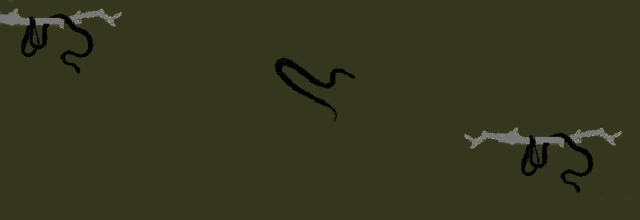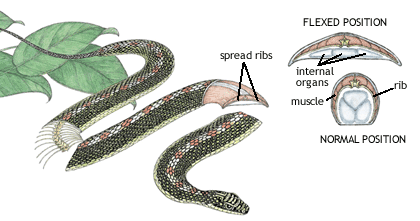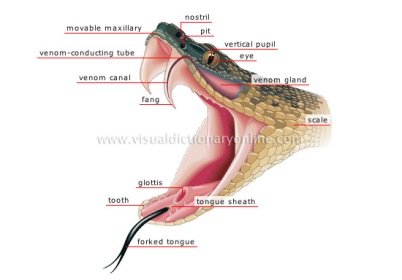Aerial Adaptation and the Basics
1. Perhaps most unique characteristic of the Genus Chrysopelea is their inherent ability to glide. The species do this in a very unique way. the snake begins by climbing up the tree. Once at a height the snake deems suitable, he/she climbs out on to the horizontal limbs. In preparation for the flight, the snake then slips the upper half of its body off the branch, dangling in a j shape. The serpent then leaps into the air, using the powerful muscles in the lower half of its body. Upon lift off, the snake snake stretches out its ribs, instantly flattening the body and taking on an s shape. This action also causes the belly region of the snake to take on a concave shape that acts as a parachute. The snakes plan is to merely enlarge its surface area and increase air resistance, thus slowing its descent. During this period of flattening, the body expands to nearly double normal width. While aloft, the snake undulates and the body contorts to catch air drafts and glide. While the undulations help propel the snake, their true propose is to control the snakes direction. C. paradisi is unique among the flying snake species by the method it uses to change direction. Most species simply bank in the direction they wish to go. C. paradisi on the other hand, turns by moving the anterior portion of the snakes body. The reason as to why the this snake Genus evolved the ability to glide may be twofold; it could be an adaptation to avoid predation or it may have evolved in response to the two Genus's of lizard and one Genus of frog prey items that also inhabit this area, the Genus Rhacophorus (Flying Frogs), Genus Draco (Flying Dragons or Gliding Lizards, and the Genus Ptychozoon (the Gliding Geckos).
2. Like all other snakes, Chrysopelea paradisi has the ability to swallow prey whole. This is possible thanks to a special, hinged jaw, called a Quadrate hinge, that allows the jaw to virtually unhinge from the skull. Since the two sides of the bottom jaw are not connected, the strong musculature of the jaw is able operate the two bones of the jaw of each other, working their way down the prey and pulling it in. They also possess a glottis, a tube that connects to the trachea that they use as a type of snorkel that extends around the prey and out the side of the mouth to take in air while eating.
3. The Paradise Tree snake is also a rear fanged venomous snake. They have a simple fang structure that, unlike vipers and other front-fanged venomous species, lacks the hypodermic-like structure. Instead, they possess a simple groove that extends vertically up the fang. The mild venom that is produced in the saliva then drips/flows down into the wound. To enhance the effectiveness of the very mild venom, the snake sort of chews the wound to try and work in as much venom as possible.
***Note: The image to the right is not a representation of the paradise tree snake skull, it is there to merely show what a glottis is***
Below is a video of Chrysopelea paradisi chasing after one of its favorite prey items and shows off the quality after which it was named.
Hard landing? Descend to Classification. Feeling lonesome? ascend to the Interactions branch by clicking the snake.



